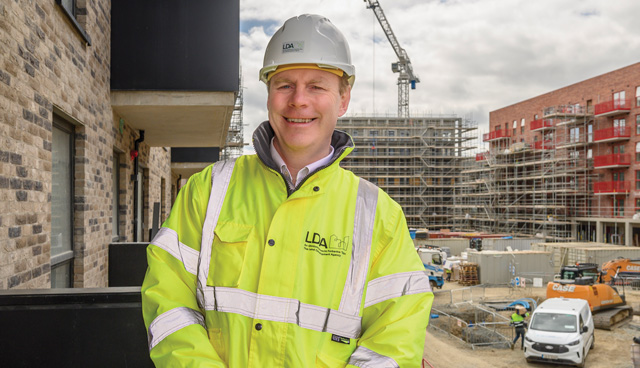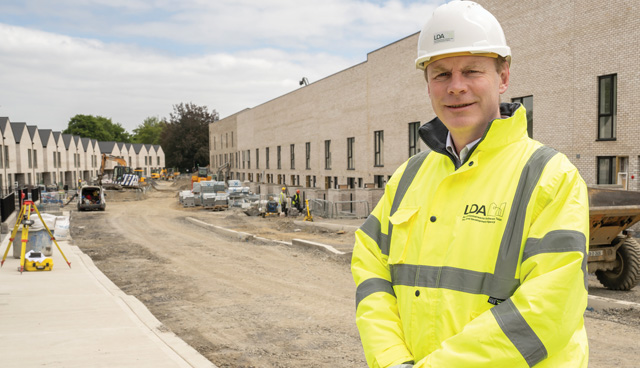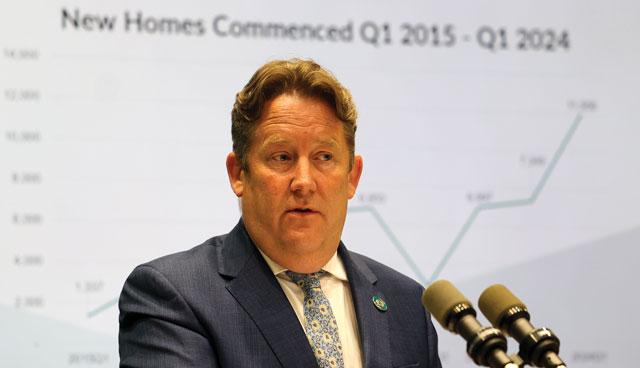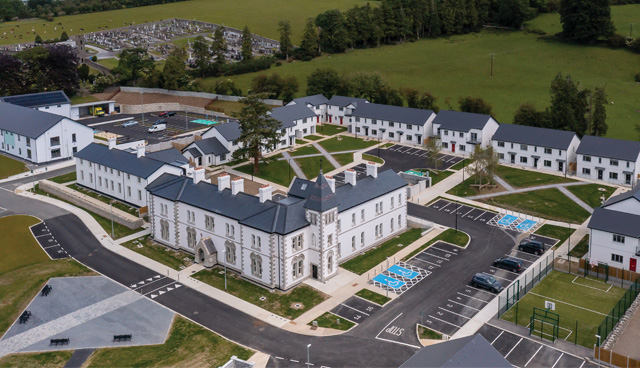
Decades of housing interventions have not resolved ‘fundamentally systemic failures’
4th July 2024
Housing Minister Darragh O’Brien TD: ‘What we are doing is radical’
4th July 2024Cover story: A partnership approach

As the first media on site at the State’s largest public housing scheme since ground was broken in November 2022, Housing Ireland Magazine gets a sense of the scale of the Land Development Agency’s (LDA) flagship project with Dún Laoghaire-Rathdown County Council at Shanganagh, south Dublin, and talks partnership, direct delivery, Project Tosaigh, and land acquisition with CEO, John Coleman.
As the commercial state-sponsored body tasked with delivering affordable housing, the LDA plans to deliver around 18,000 homes by in the coming years – over 10,000 on state-owned or acquired land, and over 8,000 via Project Tosaigh (a catalyst for unviable housebuilder-led projects).
Upon the LDA’s establishment, 40 per cent of housing delivered on state-owned land was intended for social and affordable homes, with the balance contributing to new supply to meet wider demands in private rental and purchase.
However, when Part 9 of the Land Development Agency Act came into effect from 1 January 2023, its affordability requirement increased the minimum percentage of affordable and social units delivered in residential developments on relevant public land to 100 per cent in Dublin and Cork, and 70 per cent in other urban areas.
“In this context, the LDA was agile enough to evolve amid a fundamental shift in its financial and capital requirements – both of which have grown exponentially,” Coleman observes.
Now, the LDA’s primary focus is “getting as many direct delivery projects up and running as possible” on sites sourced from state bodies – primarily local authorities – alongside the acquisition of private land.
Direct delivery
From a standing start, whereby it had no access to architects or design teams and no confirmed access to sites, the LDA now has planning approval for over 5,000 homes on directly controlled sites and a delivery pipeline of over 10,000 homes. As such, the direct delivery trajectory of the LDA is roughly equivalent to that of the largest PLC housebuilders in the State.
“We are now in a situation whereby we will be at construction phase on six or seven direct delivery sites by the end of 2024,” Coleman outlines.
These sites include:
- the former site of St Kevin’s Hospital, Cork city;
- Shanganagh, County Dublin;
- Castlelands, Balbriggan, County Dublin;
- Hacketstown, Skerries, County Dublin;
- Devoy Barracks, Nass, County Kildare; and
- St Teresa’s Gardens, Dublin 8.
Shanganagh
Later in 2024, the LDA will reach a significant milestone on its direct delivery journey when the first homes are delivered at its nine-hectare site in Shanganagh, Shankill, Dublin. In collaboration with Dún Laoghaire-Rathdown County Council, construction began at Shanganagh in November 2022.
Totalling almost 600 homes, Shanganagh is currently the largest public housing scheme in the State, as well as the largest cost rental scheme. From an LDA perspective, it is a flagship project which demonstrates how the agency can work with and provide services to local authorities.
All 597 homes are earmarked for social and affordable housing, with 306 intended to become cost rental units. A further 200 will be social housing units and 91 will be made available for affordable purchase.
Affordability
Regularly scrutinising its costs, the LDA CEO has concluded that there is no panacea to reducing costs. Rather, Coleman indicates, it requires “a layering of 0.25 per cent savings here and 0.5 per cent savings there”.
As such, in addition to seeking value for money through land acquisitions, the LDA has established a standardised apartment design, published in the form of an apartment typology booklet which it provides to all its design teams.
“Fundamentally, the fabric of the building should be the same from one LDA development to the next. However, that does mean that all apartments must look the same – they can have different skins, finishes, and facades.
“By standardising the measurements as much as possible, the supply chain can better understand our product and meet those requirements. It has been designed in collaboration with stakeholders, such as developers, to remove the inefficiencies which can exist in a site-by-site approach to design,” the LDA CEO explains.
Shanganagh has effectively been a catalytic project…
John Coleman, CEO, Land Development Agency
Sustainability
When the 597 homes at Shanganagh are completed – and more than 1,500 people live there – Coleman believes that it will emerge as a distinct and sustainable community.
“It has good facilities on site, including neighbourhood retail, a gym, playgrounds, and an impressive crèche,” he observes, adding: “It is also very well connected to the broader community in Shankill, with excellent public transport links set to be delivered through a new BusConnects route and the new Woodbrook DART station between Shankill and Bray.”
Shanganagh is also one of the largest passive housing schemes in Europe – and the largest in Ireland – with each of its units heated either by air source heat pumps or a district heating system. While previously the Passivhaus standard for energy efficiency came under intense scrutiny, mainly relating to cost, the LDA invested significant effort into understanding it.
“Through examination of the procurement process of the contractor, we determined the cost of delivering to Passivhaus standard mainly hinges on quality, craftsmanship, and airtightness. Not only are we more comfortable with Passivhaus, but we also believe that the wider industry has developed a better understanding through the LDA’s Shanganagh project.
“In fact, we have adopted an opensource approach towards other contractors and developers who want to learn more about Passivhaus and its effectiveness. This means letting them on site to examine the work that we have undertaken. Shanganagh has effectively been a catalytic project in that regard, with the LDA assuming a leadership role.”

“We target the acquisition of large-scale sites not because they are easy, but because that is where the intervention is required.”
Project Tosaigh
Designed to facilitate the completion of stalled or unviable housing projects and make the completed homes available for either cost rental or affordable purchase, the second focus of the LDA is to “increase, expand, and maintain the momentum that we have on Project Tosaigh”.
Through Project Tosaigh, the LDA has already delivered, contracted, or commercially agreed a total of 2,800 homes. “Subject to funding and ongoing support from government, the next phase should deliver around 5,000 homes,” Coleman says, adding: “Our ambition is that by the end of 2028, 8,000 homes will be delivered through the Project Tosaigh framework.”
In January 2024, the LDA announced the release of over 600 cost rental homes across four Project Tosaigh schemes – Barnwell Point in Dublin 15; The Quarter in Dublin 24; Dun Óir in Dublin 18; and Harpur Lane, Leixlip, County Kildare – alongside several affordable purchase Project Tosaigh developments, including Clonmore, Mallow, County Cork; Summerfields, Kilbarry, County Waterford; Wilkinsons Brook, Hollystown, Dublin 15; and Baker Hall, Navan, County Meath.
“In the beginning, we never envisaged that we would be accelerating delivery through housebuilder partnerships,” Coleman acknowledges.
Housebuilder partnerships panel
In June 2024, the LDA finalised the establishment of a four-year framework panel which, Coleman believes, “will be a major step forward in facilitating the expansion of the Project Tosaigh programme”.
With a stated purpose of accelerating the delivery of affordable homes, the panel comprises 15 of Ireland’s largest and most experienced housebuilders and provides several delivery partnership options to ease financing challenges, including via a forward funding mechanism to facilitate staged payments to housebuilders.
Marking a step change in the LDA’s delivery of homes, under the second phase of Project Tosaigh, the agency will finance housing projects throughout the construction phase as housebuilders achieve development milestones. This is set to consolidate collaboration between the LDA and housebuilders.
“With the LDA more involved in design and financing, the creation of the panel is intended to expediate delivery through incentivisation while also ensuring value for money for the State.
“In providing staged payments, the LDA can ensure greater certainty for housebuilders resulting in quicker transactions and contracting. This reduces cost by avoiding lenders’ high interest rates, and ultimately unlocks better value for the LDA,” Coleman explains.
Local authority partnerships
When the LDA was established, its relationship with the local authorities was open to misinterpretation. “The reality,” Coleman notes, “is that the LDA is totally complementary to local authorities and exists to support them to achieve their housing delivery objectives.
“Our role, as embedded in the Land Development Agency Act 2021, is to provide services to local authorities. That is what we are doing here at Shanganagh where we have provided Dún Laoghaire-Rathdown County Council with design services and project management services, as well as having financed construction. We are set to operate a portion of the units as cost rental homes upon completion. Shanganagh is an archetype of what we can achieve in partnership with the local authorities.”
Land acquisition programme
Alongside affordable housing delivery, the LDA’s strategic remit includes strategic land assembly. Having identified a need and an opportunity to purchase private land for the direct delivery of affordable housing, the LDA launched its land acquisition programme and sought expressions of interest from landowners in September 2023.
Initially the focus of the acquisition programme is the delivery of high-density housing on large-scale sites with existing planning permission for 200 homes and above in Dublin, Cork, Limerick, Galway, and Waterford.
The three criteria that must be met for the LDA to enter material discussions with vendors are:
- location;
- scale; and
- value.
In total, the LDA received 60 submissions from landowners, several of which were rejected because it was assessed that “the value expectations were unrealistic”; value being determined by site costs and build costs versus the projected price from the sale of the finished units.
“Given that the State is the only buyer of apartments in particular, through various guises, including the LDA, approved housing bodies (AHBs), and local authorities, we wanted to impress our focus on value in relation to land. We want to ensure that the end unit price is kept as low as possible,” Coleman says.
Large-scale sites
Suggesting that the LDA is one of the few organisations that can deliver on large-scale sites, given the timelines involved, he insists that the agency does not want to compete with private developers.
“We take a pragmatic view. If a site is going to be delivered by a private developer, meaning the homes will be built but the LDA will not have to build or finance them, that is a positive outcome. We want to complement the activity of private developers,” he emphasises.
Clongriffin
Instead, the LDA’s role is to intervene in scenarios where delivery is more difficult. “We target the acquisition of large-scale sites not because they are easy, but because that is where the intervention is required. For instance, no one else in the market could have taken on the Clongriffin site and now the LDA is tendering for the first phase of 408 homes.”
Despite its scale, Shanganagh is not the largest scheme that the LDA is working on. As the first land acquisition that the agency proceeded with, the 13.2-hectare site located adjacent to the Clongriffin railway station in Dublin 13 has the potential to deliver a total of 2,300 homes.
“By virtue of the scale of the site, we agreed a price equating to around €19,000 per unit,” the LDA CEO states. “This represents good value, especially in the context where an apartment can cost over €400,000 to deliver.”
However, Coleman agrees with the assessment of the LDA’s Head of Property, Phelim O’Neill, that “some land pricing is unrealistic”. “As realism sets into the market, that is changing and must change further. Hopefully we will have more opportunities to announce further deals in the coming months,” he remarks.
Delivery challenges
Discussing the challenges facing the LDA’s delivery of affordable housing, Coleman identifies three:
- access to land;
- planning; and
- cost.
Access to land
Firstly, while the LDA is tasked with delivering affordable housing on state land, it has no powers to compel state bodies to provide it with that land. While acknowledging the nuances of why state bodies might hold land, Coleman suggests that a balance must be struck.
“There is a constant tension between current use and the significant housing need that we have. It is no coincidence that the LDA has entered the private market where we see value. Consider how long it may take us to extract a state-owned site relative to acquiring a site such as Clongriffin.
“Enhanced powers, either for the LDA or the Government itself, to compel the release of land would assist in unlocking opportunities to deliver affordable housing on state lands,” he asserts.
Planning
Secondly, while planning remains a challenge, Coleman observes some improvement.
Referencing the ongoing judicial review which has subsequently delayed the delivery of 852 affordable homes on the former site of the Central Mental Hospital in Dundrum, the LDA CEO is keenly anticipating the enactment of the Planning and Development Bill 2023, which, among other objectives, is intended to “provide for proper planning and sustainable development in the interests of the common good”.
“The LDA believes that the forthcoming legislation is a very positive step” Coleman comments, adding: “The new legislation should provide clarity around timeframes for planning, rebalancing scenarios in which administrative mistakes can result in planning applications reverting to the beginning of the process as opposed to simply being remedied.
“We are optimistic that the enactment of the Bill will have a materially positive effect in relation to the overall planning ecosystem. We are very supportive of the Government’s efforts.”
Cost
Finally, the cost of housing delivery in Ireland remains high. For instance, the average cost of delivering a new three-bed semidetached house ranges from €354,000 in the northwest to €461,000 in the Greater Dublin Area. Similarly, over the total deliver cost for a two-bed medium-rise apartment is more than €400,000.
In this context, delivering truly affordable rent for the LDA’s target market is a challenge. While suggesting that “government has responded well through the delivery of the Secure Tenancy Affordable Rental investment scheme (STAR)”, Coleman believes that costs will continue to be challenge and “there is no sign of them abating, even amid reducing inflation levels”.
Reflecting on these challenges, the LDA chief characterises them as “obstacles that we must be overcome”. “Nothing worthwhile is easy to deliver and we will continue with a positive attitude to overcome these obstacles through collaboration, partnership, engagement, and dialogue,” he adds.
Vision
In summarising, Coleman outlines three major ambitions for the LDA:
- achieving delivery at scale;
- proving the cost rental tenure model; and
- refining the LDA’s finance model.
“Firstly, we aim to build a pipeline of such scale that we can produce over 2,000 homes on direct delivery sites per annum. Secondly, cost rental has the potential to be one of the main housing tenures in this state and to prove that model it needs to get to scale.
“Thirdly, while the LDA will always be reliant on government, broadening our finance model over time through more diverse funding options would make us more resilient and counter cyclical,” he concludes.
| John Coleman
Living in Dundrum, south Dublin, with a young family – including three children in national school – John Coleman is a keen cyclist. Having completed L’Étape du Tour de France in 2022 and the Marmotte Granfondo Alpes in 2023, he is in training to repeat the latter in 2024. “Generally in life, I perform better under pressure. Facing a big challenge drives me on to achieve something that I might not otherwise achieve. So, I sign up to challenging cycling events every summer and that forces me onto the bike through the winter,” he reflects. |







